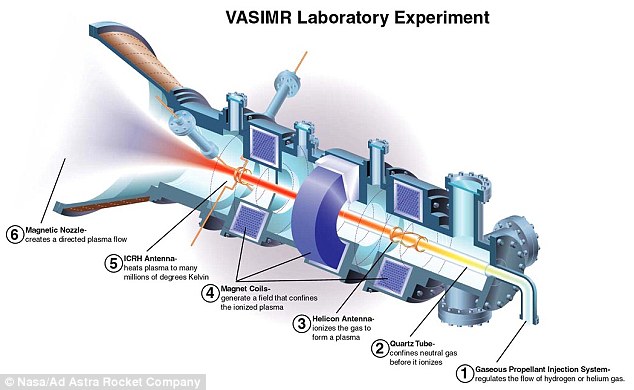I have been blogging about Mars lately. Mars is the planet most likely to be visited by astronauts. The human race has been fascinated by Mars for over a hundred and fifty years. There were plans after we landed on the Moon in 1969 to continue on with visits to Mars in the coming decades. For political reasons, these ambitious plans were dropped and forty five years have passed since the Moon landing and there has been no visit to Mars. Now Mars is on the table again with NASA plans to send astronauts to Mars in the coming decades. With the advent of private companies developing their own launch systems and plans to exploit space, the urge to visit Mars has spread to the private sector.
One of the barriers to visiting Mars is the projected length of the trip to and from Mars. With conventional engines and spacecraft, just traveling to Mars will take nine months. The astronauts will have to wait a year for the return trip which will take another nine months. Questions of fuel, supplies, psychological stress, and radiation damage make such an expedition very difficult and expensive. If the time required to get to Mars and back could be shortened significantly, the trip would be cheaper, safer and more likely to succeed. There are private companies working on spaceship engines that hold the promise of getting us to Mars much more quickly.
The Ad Astra Rocket company in Texas is currently working on the Vasimr plasma engine. The company held a successful test of a prototype 2013. Now NASA is considering the use of the Vasimr engine for a Mars expedition. During the next three years, NASA will provide about ten million dollars to the AAR to get the engine "almost ready for space." This phase will end with a one hundred hour continuous firing of the AAR VX-200-SS prototype. There have been more than ten thousand successful firings of AAR engines so far but these were all short firings. Continuous firing will be necessary for use in space missions.
Plasma engines function by creating a ionized gas which is then accelerated by electromagnetic fields to propel the vehicle. There are many different designs for plasma engines. Very little fuel is required for a plasma engine. Water is a possible fuel. While the actual motive force of a plasma engine is weak, it can fire continuously for long periods and build up high acceleration over time. It is estimated that a Vasimr type engine could take a spacecraft to Mars in 39 days.
With respect to such public-private project NASA has said, "Commercial partners were selected for their technical ability to mature key technologies and their commitment to the potential applications both for government and private sector uses." and "This work ultimately will inform the strategy to move human presence further into the solar system." There are three projects in progress, including Vasimr, to develop electric propulsion systems in the fifty to three hundred kilowatt range for space missions. Current NASA plasma propulsions systems function with less than five kilowatts.
